Construction Law - Tiger Tunnel Construction Limited
VerifiedAdded on 2022/08/18
|12
|2922
|18
AI Summary
Contribute Materials
Your contribution can guide someone’s learning journey. Share your
documents today.

Running Header: CONSTRUCTION LAW 1
Subject: Property Law
Construction Law
University
By
(Name)
(Date)
Subject: Property Law
Construction Law
University
By
(Name)
(Date)
Secure Best Marks with AI Grader
Need help grading? Try our AI Grader for instant feedback on your assignments.

Running Header: CONSTRUCTION LAW 2
Table of Contents
Abstract.......................................................................................................................................................1
Introduction.................................................................................................................................................1
Body............................................................................................................................................................1
Conclusion...................................................................................................................................................4
Dispute Avoidance.......................................................................................................................................5
Employer.................................................................................................................................................5
Contract Administrator............................................................................................................................5
Contractor...............................................................................................................................................5
Table of Contents
Abstract.......................................................................................................................................................1
Introduction.................................................................................................................................................1
Body............................................................................................................................................................1
Conclusion...................................................................................................................................................4
Dispute Avoidance.......................................................................................................................................5
Employer.................................................................................................................................................5
Contract Administrator............................................................................................................................5
Contractor...............................................................................................................................................5
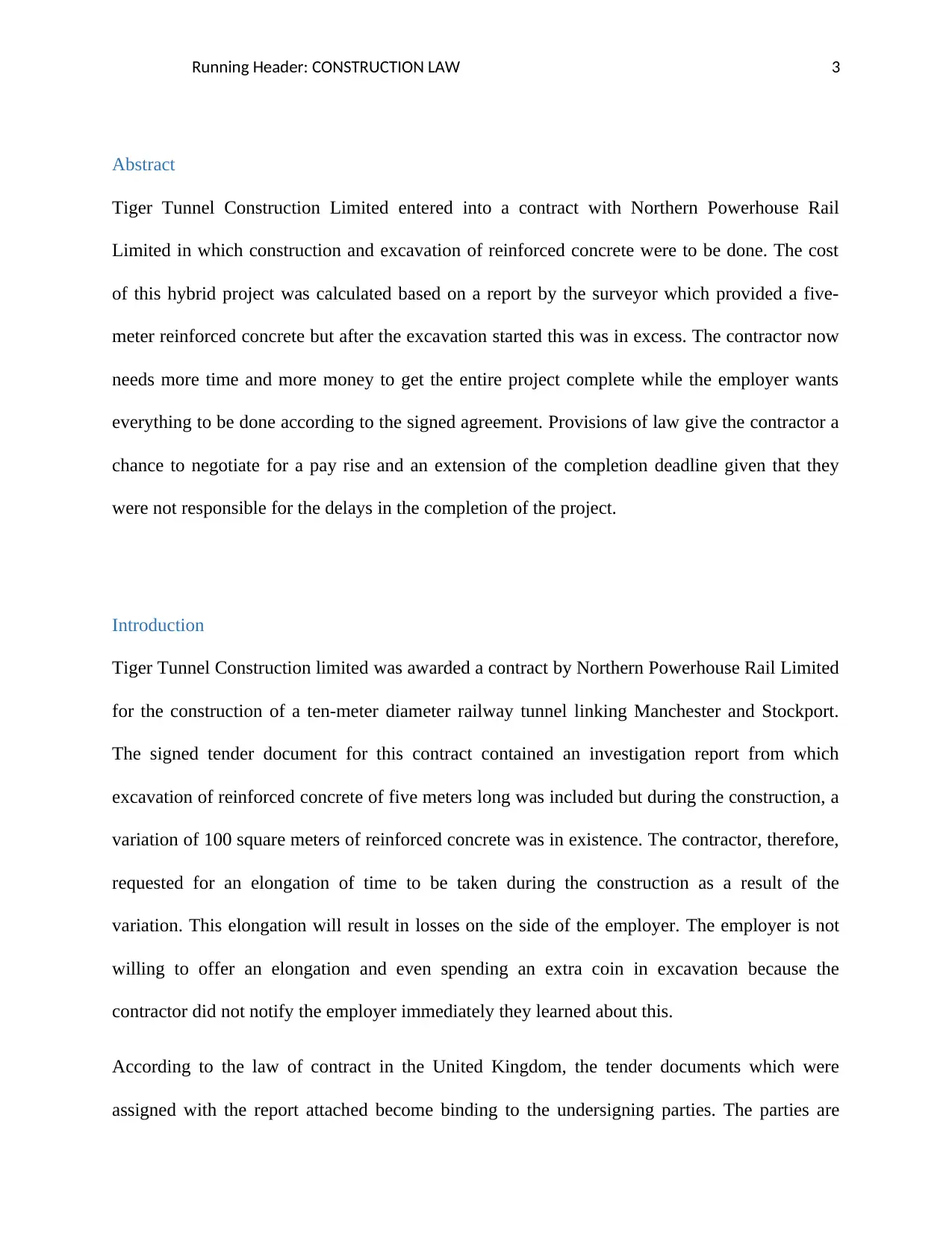
Running Header: CONSTRUCTION LAW 3
Abstract
Tiger Tunnel Construction Limited entered into a contract with Northern Powerhouse Rail
Limited in which construction and excavation of reinforced concrete were to be done. The cost
of this hybrid project was calculated based on a report by the surveyor which provided a five-
meter reinforced concrete but after the excavation started this was in excess. The contractor now
needs more time and more money to get the entire project complete while the employer wants
everything to be done according to the signed agreement. Provisions of law give the contractor a
chance to negotiate for a pay rise and an extension of the completion deadline given that they
were not responsible for the delays in the completion of the project.
Introduction
Tiger Tunnel Construction limited was awarded a contract by Northern Powerhouse Rail Limited
for the construction of a ten-meter diameter railway tunnel linking Manchester and Stockport.
The signed tender document for this contract contained an investigation report from which
excavation of reinforced concrete of five meters long was included but during the construction, a
variation of 100 square meters of reinforced concrete was in existence. The contractor, therefore,
requested for an elongation of time to be taken during the construction as a result of the
variation. This elongation will result in losses on the side of the employer. The employer is not
willing to offer an elongation and even spending an extra coin in excavation because the
contractor did not notify the employer immediately they learned about this.
According to the law of contract in the United Kingdom, the tender documents which were
assigned with the report attached become binding to the undersigning parties. The parties are
Abstract
Tiger Tunnel Construction Limited entered into a contract with Northern Powerhouse Rail
Limited in which construction and excavation of reinforced concrete were to be done. The cost
of this hybrid project was calculated based on a report by the surveyor which provided a five-
meter reinforced concrete but after the excavation started this was in excess. The contractor now
needs more time and more money to get the entire project complete while the employer wants
everything to be done according to the signed agreement. Provisions of law give the contractor a
chance to negotiate for a pay rise and an extension of the completion deadline given that they
were not responsible for the delays in the completion of the project.
Introduction
Tiger Tunnel Construction limited was awarded a contract by Northern Powerhouse Rail Limited
for the construction of a ten-meter diameter railway tunnel linking Manchester and Stockport.
The signed tender document for this contract contained an investigation report from which
excavation of reinforced concrete of five meters long was included but during the construction, a
variation of 100 square meters of reinforced concrete was in existence. The contractor, therefore,
requested for an elongation of time to be taken during the construction as a result of the
variation. This elongation will result in losses on the side of the employer. The employer is not
willing to offer an elongation and even spending an extra coin in excavation because the
contractor did not notify the employer immediately they learned about this.
According to the law of contract in the United Kingdom, the tender documents which were
assigned with the report attached become binding to the undersigning parties. The parties are
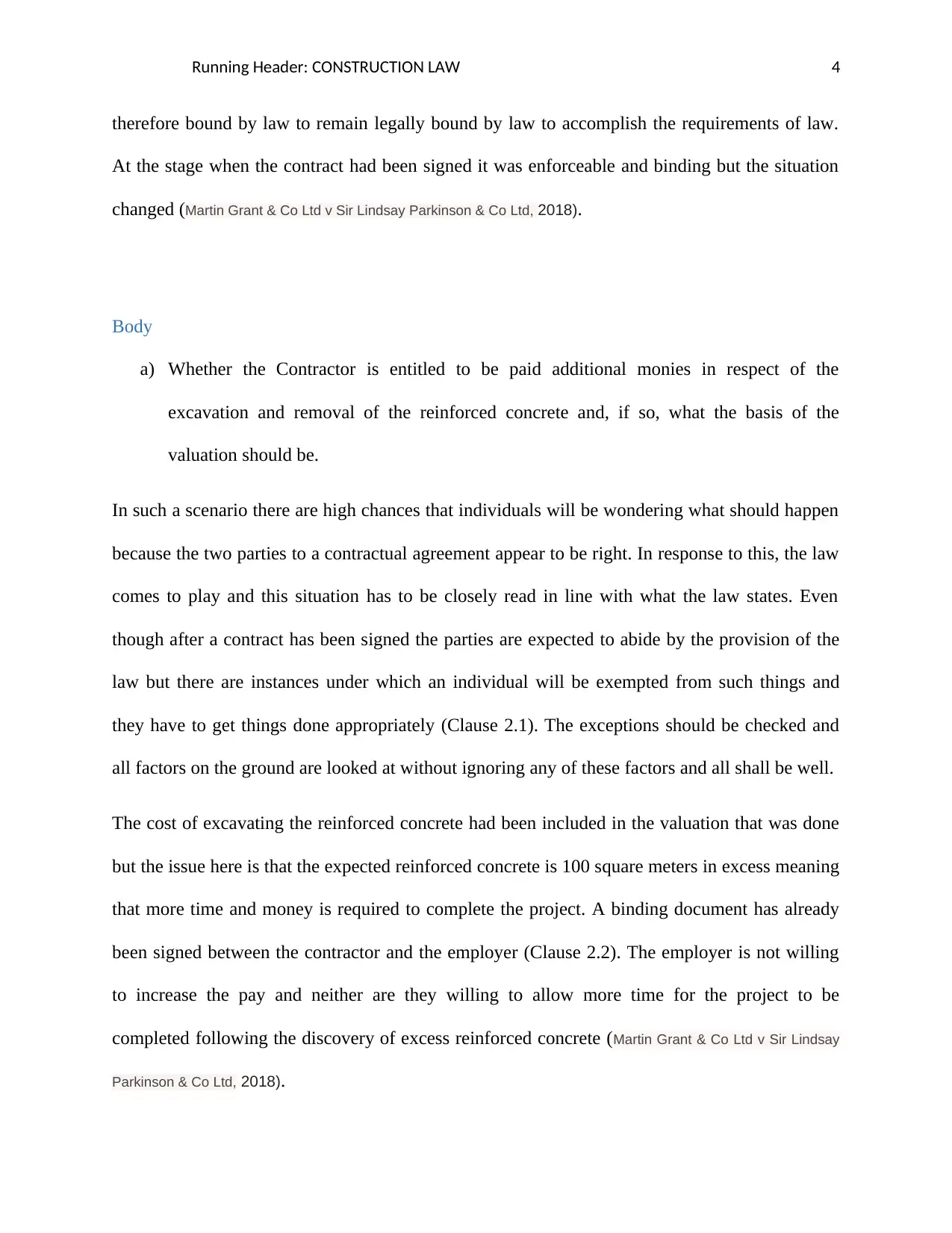
Running Header: CONSTRUCTION LAW 4
therefore bound by law to remain legally bound by law to accomplish the requirements of law.
At the stage when the contract had been signed it was enforceable and binding but the situation
changed (Martin Grant & Co Ltd v Sir Lindsay Parkinson & Co Ltd, 2018).
Body
a) Whether the Contractor is entitled to be paid additional monies in respect of the
excavation and removal of the reinforced concrete and, if so, what the basis of the
valuation should be.
In such a scenario there are high chances that individuals will be wondering what should happen
because the two parties to a contractual agreement appear to be right. In response to this, the law
comes to play and this situation has to be closely read in line with what the law states. Even
though after a contract has been signed the parties are expected to abide by the provision of the
law but there are instances under which an individual will be exempted from such things and
they have to get things done appropriately (Clause 2.1). The exceptions should be checked and
all factors on the ground are looked at without ignoring any of these factors and all shall be well.
The cost of excavating the reinforced concrete had been included in the valuation that was done
but the issue here is that the expected reinforced concrete is 100 square meters in excess meaning
that more time and money is required to complete the project. A binding document has already
been signed between the contractor and the employer (Clause 2.2). The employer is not willing
to increase the pay and neither are they willing to allow more time for the project to be
completed following the discovery of excess reinforced concrete (Martin Grant & Co Ltd v Sir Lindsay
Parkinson & Co Ltd, 2018).
therefore bound by law to remain legally bound by law to accomplish the requirements of law.
At the stage when the contract had been signed it was enforceable and binding but the situation
changed (Martin Grant & Co Ltd v Sir Lindsay Parkinson & Co Ltd, 2018).
Body
a) Whether the Contractor is entitled to be paid additional monies in respect of the
excavation and removal of the reinforced concrete and, if so, what the basis of the
valuation should be.
In such a scenario there are high chances that individuals will be wondering what should happen
because the two parties to a contractual agreement appear to be right. In response to this, the law
comes to play and this situation has to be closely read in line with what the law states. Even
though after a contract has been signed the parties are expected to abide by the provision of the
law but there are instances under which an individual will be exempted from such things and
they have to get things done appropriately (Clause 2.1). The exceptions should be checked and
all factors on the ground are looked at without ignoring any of these factors and all shall be well.
The cost of excavating the reinforced concrete had been included in the valuation that was done
but the issue here is that the expected reinforced concrete is 100 square meters in excess meaning
that more time and money is required to complete the project. A binding document has already
been signed between the contractor and the employer (Clause 2.2). The employer is not willing
to increase the pay and neither are they willing to allow more time for the project to be
completed following the discovery of excess reinforced concrete (Martin Grant & Co Ltd v Sir Lindsay
Parkinson & Co Ltd, 2018).
Secure Best Marks with AI Grader
Need help grading? Try our AI Grader for instant feedback on your assignments.
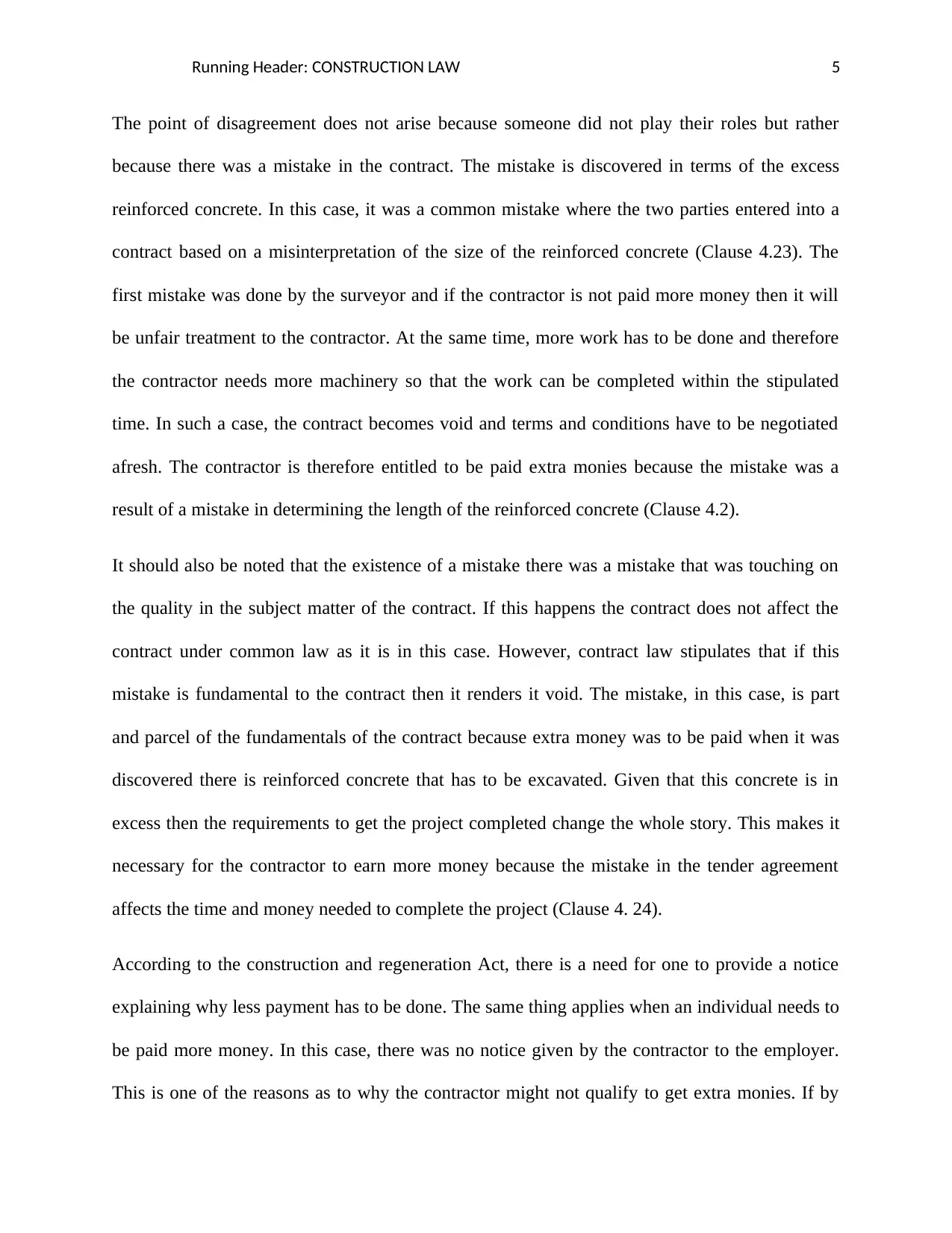
Running Header: CONSTRUCTION LAW 5
The point of disagreement does not arise because someone did not play their roles but rather
because there was a mistake in the contract. The mistake is discovered in terms of the excess
reinforced concrete. In this case, it was a common mistake where the two parties entered into a
contract based on a misinterpretation of the size of the reinforced concrete (Clause 4.23). The
first mistake was done by the surveyor and if the contractor is not paid more money then it will
be unfair treatment to the contractor. At the same time, more work has to be done and therefore
the contractor needs more machinery so that the work can be completed within the stipulated
time. In such a case, the contract becomes void and terms and conditions have to be negotiated
afresh. The contractor is therefore entitled to be paid extra monies because the mistake was a
result of a mistake in determining the length of the reinforced concrete (Clause 4.2).
It should also be noted that the existence of a mistake there was a mistake that was touching on
the quality in the subject matter of the contract. If this happens the contract does not affect the
contract under common law as it is in this case. However, contract law stipulates that if this
mistake is fundamental to the contract then it renders it void. The mistake, in this case, is part
and parcel of the fundamentals of the contract because extra money was to be paid when it was
discovered there is reinforced concrete that has to be excavated. Given that this concrete is in
excess then the requirements to get the project completed change the whole story. This makes it
necessary for the contractor to earn more money because the mistake in the tender agreement
affects the time and money needed to complete the project (Clause 4. 24).
According to the construction and regeneration Act, there is a need for one to provide a notice
explaining why less payment has to be done. The same thing applies when an individual needs to
be paid more money. In this case, there was no notice given by the contractor to the employer.
This is one of the reasons as to why the contractor might not qualify to get extra monies. If by
The point of disagreement does not arise because someone did not play their roles but rather
because there was a mistake in the contract. The mistake is discovered in terms of the excess
reinforced concrete. In this case, it was a common mistake where the two parties entered into a
contract based on a misinterpretation of the size of the reinforced concrete (Clause 4.23). The
first mistake was done by the surveyor and if the contractor is not paid more money then it will
be unfair treatment to the contractor. At the same time, more work has to be done and therefore
the contractor needs more machinery so that the work can be completed within the stipulated
time. In such a case, the contract becomes void and terms and conditions have to be negotiated
afresh. The contractor is therefore entitled to be paid extra monies because the mistake was a
result of a mistake in determining the length of the reinforced concrete (Clause 4.2).
It should also be noted that the existence of a mistake there was a mistake that was touching on
the quality in the subject matter of the contract. If this happens the contract does not affect the
contract under common law as it is in this case. However, contract law stipulates that if this
mistake is fundamental to the contract then it renders it void. The mistake, in this case, is part
and parcel of the fundamentals of the contract because extra money was to be paid when it was
discovered there is reinforced concrete that has to be excavated. Given that this concrete is in
excess then the requirements to get the project completed change the whole story. This makes it
necessary for the contractor to earn more money because the mistake in the tender agreement
affects the time and money needed to complete the project (Clause 4. 24).
According to the construction and regeneration Act, there is a need for one to provide a notice
explaining why less payment has to be done. The same thing applies when an individual needs to
be paid more money. In this case, there was no notice given by the contractor to the employer.
This is one of the reasons as to why the contractor might not qualify to get extra monies. If by
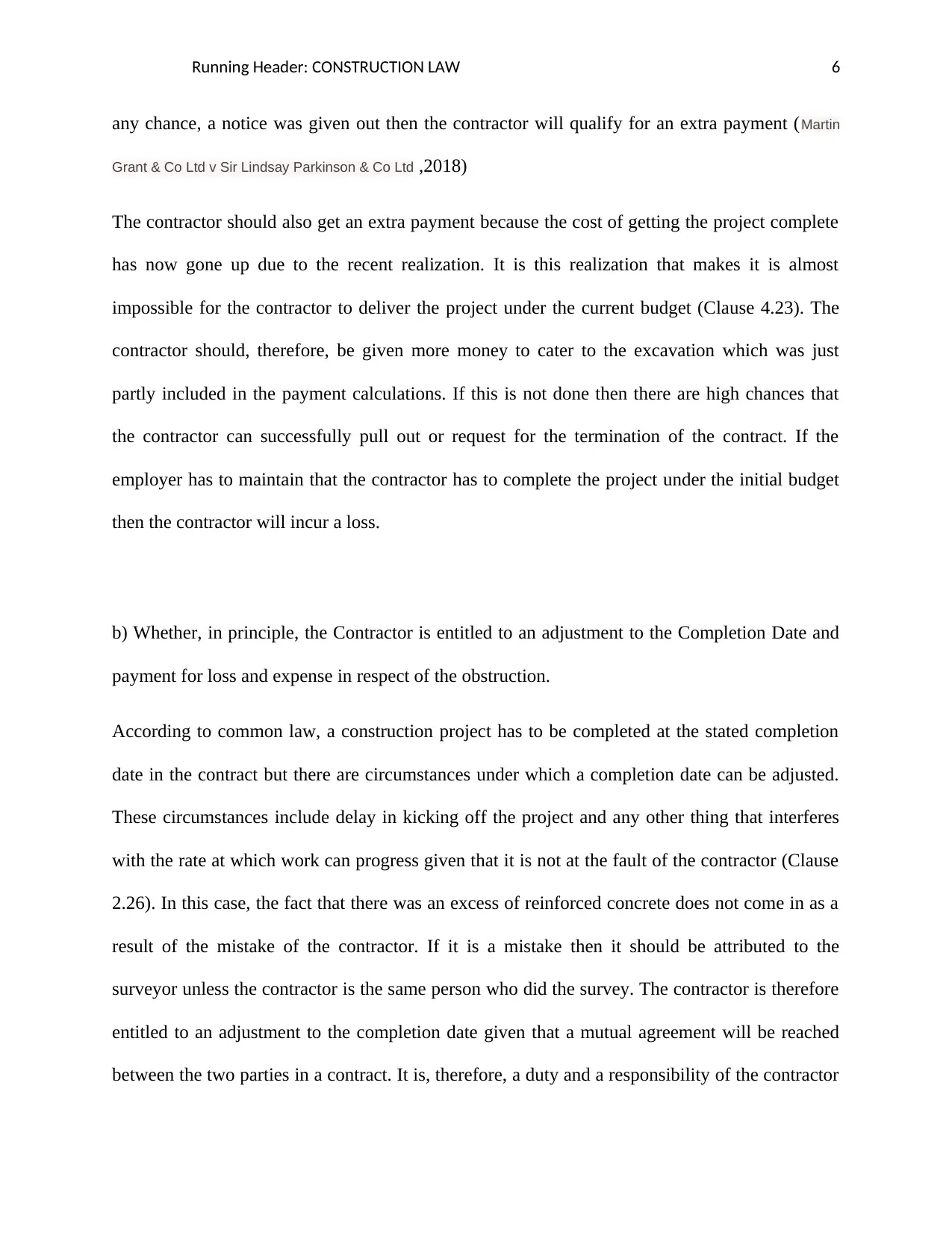
Running Header: CONSTRUCTION LAW 6
any chance, a notice was given out then the contractor will qualify for an extra payment (Martin
Grant & Co Ltd v Sir Lindsay Parkinson & Co Ltd ,2018)
The contractor should also get an extra payment because the cost of getting the project complete
has now gone up due to the recent realization. It is this realization that makes it is almost
impossible for the contractor to deliver the project under the current budget (Clause 4.23). The
contractor should, therefore, be given more money to cater to the excavation which was just
partly included in the payment calculations. If this is not done then there are high chances that
the contractor can successfully pull out or request for the termination of the contract. If the
employer has to maintain that the contractor has to complete the project under the initial budget
then the contractor will incur a loss.
b) Whether, in principle, the Contractor is entitled to an adjustment to the Completion Date and
payment for loss and expense in respect of the obstruction.
According to common law, a construction project has to be completed at the stated completion
date in the contract but there are circumstances under which a completion date can be adjusted.
These circumstances include delay in kicking off the project and any other thing that interferes
with the rate at which work can progress given that it is not at the fault of the contractor (Clause
2.26). In this case, the fact that there was an excess of reinforced concrete does not come in as a
result of the mistake of the contractor. If it is a mistake then it should be attributed to the
surveyor unless the contractor is the same person who did the survey. The contractor is therefore
entitled to an adjustment to the completion date given that a mutual agreement will be reached
between the two parties in a contract. It is, therefore, a duty and a responsibility of the contractor
any chance, a notice was given out then the contractor will qualify for an extra payment (Martin
Grant & Co Ltd v Sir Lindsay Parkinson & Co Ltd ,2018)
The contractor should also get an extra payment because the cost of getting the project complete
has now gone up due to the recent realization. It is this realization that makes it is almost
impossible for the contractor to deliver the project under the current budget (Clause 4.23). The
contractor should, therefore, be given more money to cater to the excavation which was just
partly included in the payment calculations. If this is not done then there are high chances that
the contractor can successfully pull out or request for the termination of the contract. If the
employer has to maintain that the contractor has to complete the project under the initial budget
then the contractor will incur a loss.
b) Whether, in principle, the Contractor is entitled to an adjustment to the Completion Date and
payment for loss and expense in respect of the obstruction.
According to common law, a construction project has to be completed at the stated completion
date in the contract but there are circumstances under which a completion date can be adjusted.
These circumstances include delay in kicking off the project and any other thing that interferes
with the rate at which work can progress given that it is not at the fault of the contractor (Clause
2.26). In this case, the fact that there was an excess of reinforced concrete does not come in as a
result of the mistake of the contractor. If it is a mistake then it should be attributed to the
surveyor unless the contractor is the same person who did the survey. The contractor is therefore
entitled to an adjustment to the completion date given that a mutual agreement will be reached
between the two parties in a contract. It is, therefore, a duty and a responsibility of the contractor
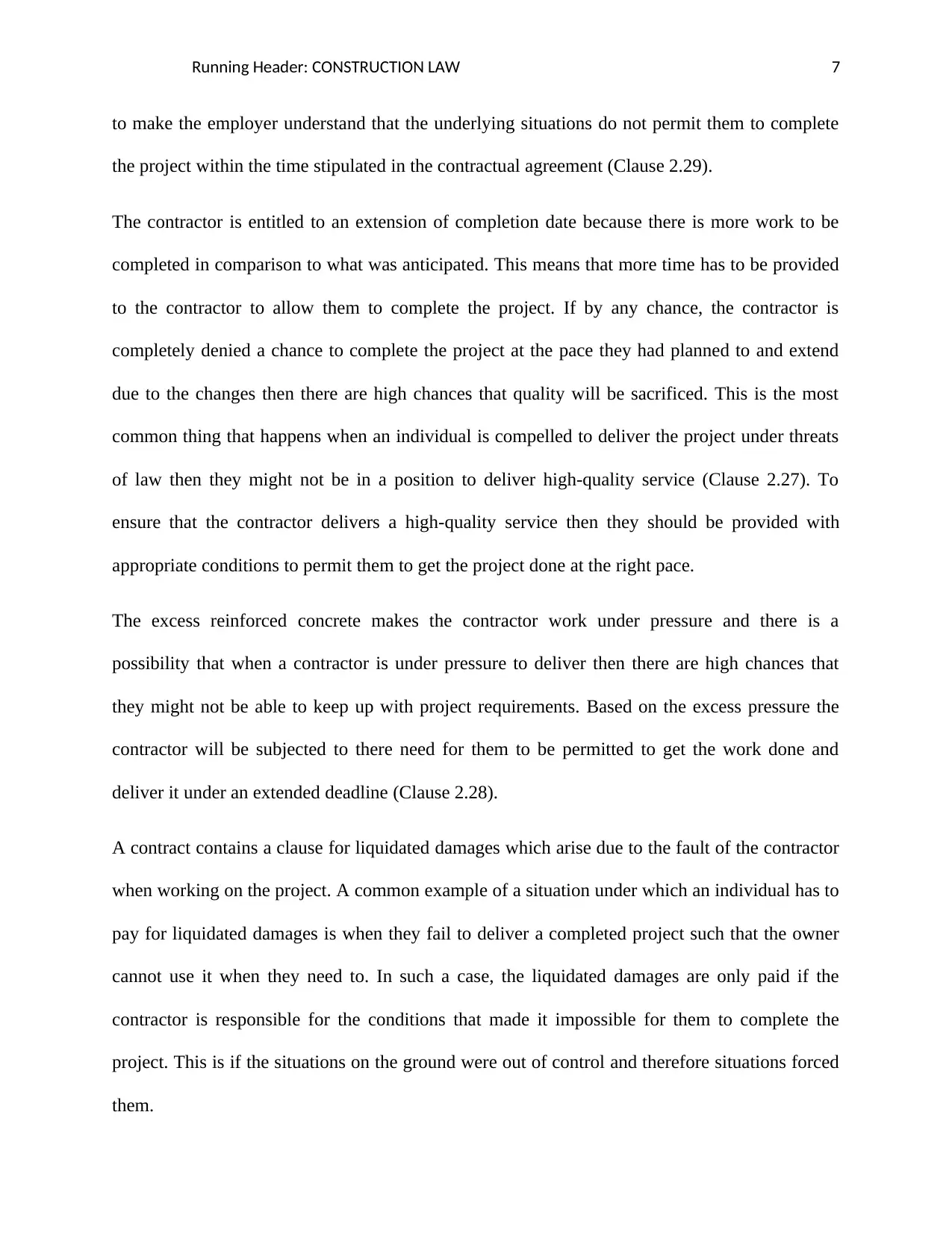
Running Header: CONSTRUCTION LAW 7
to make the employer understand that the underlying situations do not permit them to complete
the project within the time stipulated in the contractual agreement (Clause 2.29).
The contractor is entitled to an extension of completion date because there is more work to be
completed in comparison to what was anticipated. This means that more time has to be provided
to the contractor to allow them to complete the project. If by any chance, the contractor is
completely denied a chance to complete the project at the pace they had planned to and extend
due to the changes then there are high chances that quality will be sacrificed. This is the most
common thing that happens when an individual is compelled to deliver the project under threats
of law then they might not be in a position to deliver high-quality service (Clause 2.27). To
ensure that the contractor delivers a high-quality service then they should be provided with
appropriate conditions to permit them to get the project done at the right pace.
The excess reinforced concrete makes the contractor work under pressure and there is a
possibility that when a contractor is under pressure to deliver then there are high chances that
they might not be able to keep up with project requirements. Based on the excess pressure the
contractor will be subjected to there need for them to be permitted to get the work done and
deliver it under an extended deadline (Clause 2.28).
A contract contains a clause for liquidated damages which arise due to the fault of the contractor
when working on the project. A common example of a situation under which an individual has to
pay for liquidated damages is when they fail to deliver a completed project such that the owner
cannot use it when they need to. In such a case, the liquidated damages are only paid if the
contractor is responsible for the conditions that made it impossible for them to complete the
project. This is if the situations on the ground were out of control and therefore situations forced
them.
to make the employer understand that the underlying situations do not permit them to complete
the project within the time stipulated in the contractual agreement (Clause 2.29).
The contractor is entitled to an extension of completion date because there is more work to be
completed in comparison to what was anticipated. This means that more time has to be provided
to the contractor to allow them to complete the project. If by any chance, the contractor is
completely denied a chance to complete the project at the pace they had planned to and extend
due to the changes then there are high chances that quality will be sacrificed. This is the most
common thing that happens when an individual is compelled to deliver the project under threats
of law then they might not be in a position to deliver high-quality service (Clause 2.27). To
ensure that the contractor delivers a high-quality service then they should be provided with
appropriate conditions to permit them to get the project done at the right pace.
The excess reinforced concrete makes the contractor work under pressure and there is a
possibility that when a contractor is under pressure to deliver then there are high chances that
they might not be able to keep up with project requirements. Based on the excess pressure the
contractor will be subjected to there need for them to be permitted to get the work done and
deliver it under an extended deadline (Clause 2.28).
A contract contains a clause for liquidated damages which arise due to the fault of the contractor
when working on the project. A common example of a situation under which an individual has to
pay for liquidated damages is when they fail to deliver a completed project such that the owner
cannot use it when they need to. In such a case, the liquidated damages are only paid if the
contractor is responsible for the conditions that made it impossible for them to complete the
project. This is if the situations on the ground were out of control and therefore situations forced
them.
Paraphrase This Document
Need a fresh take? Get an instant paraphrase of this document with our AI Paraphraser
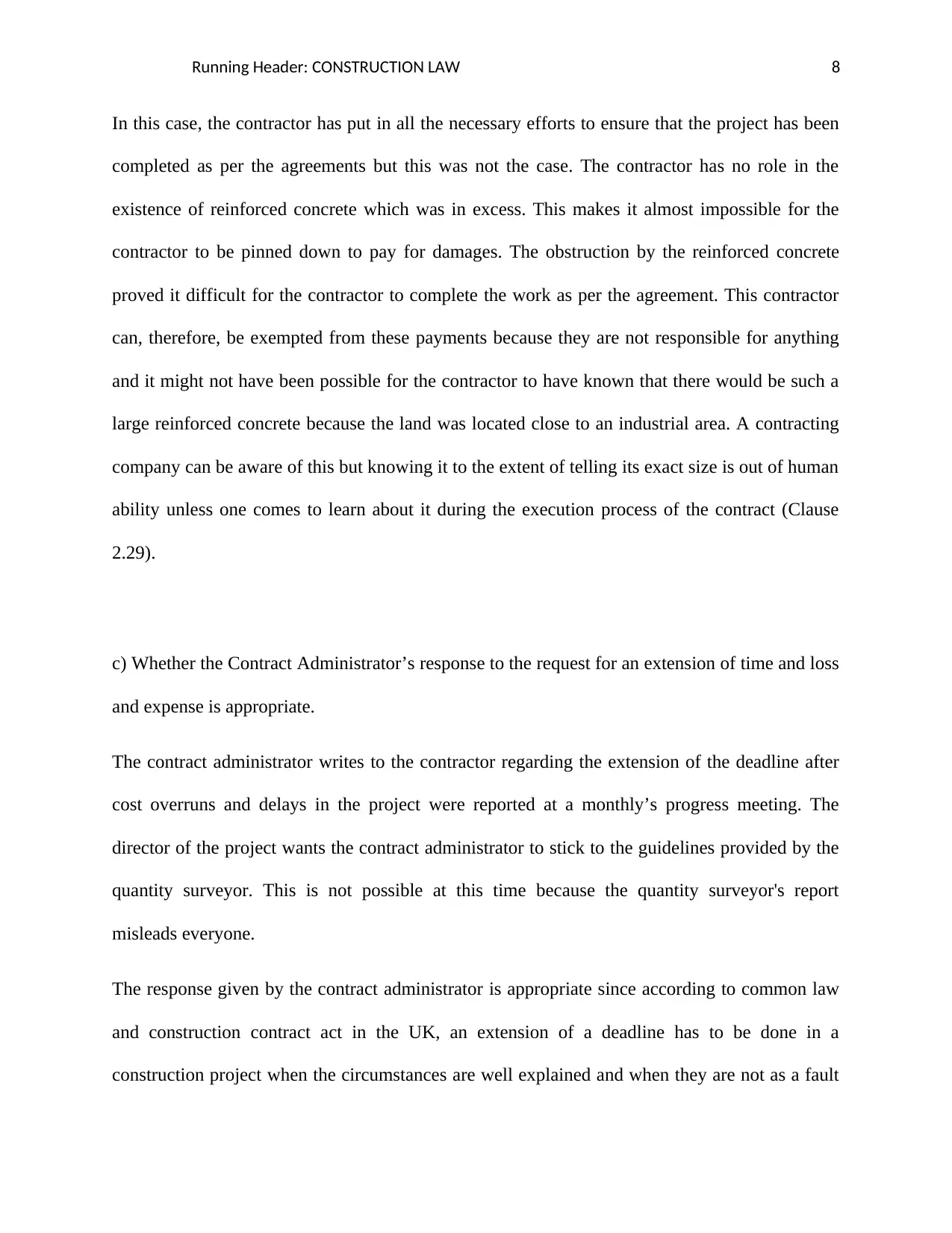
Running Header: CONSTRUCTION LAW 8
In this case, the contractor has put in all the necessary efforts to ensure that the project has been
completed as per the agreements but this was not the case. The contractor has no role in the
existence of reinforced concrete which was in excess. This makes it almost impossible for the
contractor to be pinned down to pay for damages. The obstruction by the reinforced concrete
proved it difficult for the contractor to complete the work as per the agreement. This contractor
can, therefore, be exempted from these payments because they are not responsible for anything
and it might not have been possible for the contractor to have known that there would be such a
large reinforced concrete because the land was located close to an industrial area. A contracting
company can be aware of this but knowing it to the extent of telling its exact size is out of human
ability unless one comes to learn about it during the execution process of the contract (Clause
2.29).
c) Whether the Contract Administrator’s response to the request for an extension of time and loss
and expense is appropriate.
The contract administrator writes to the contractor regarding the extension of the deadline after
cost overruns and delays in the project were reported at a monthly’s progress meeting. The
director of the project wants the contract administrator to stick to the guidelines provided by the
quantity surveyor. This is not possible at this time because the quantity surveyor's report
misleads everyone.
The response given by the contract administrator is appropriate since according to common law
and construction contract act in the UK, an extension of a deadline has to be done in a
construction project when the circumstances are well explained and when they are not as a fault
In this case, the contractor has put in all the necessary efforts to ensure that the project has been
completed as per the agreements but this was not the case. The contractor has no role in the
existence of reinforced concrete which was in excess. This makes it almost impossible for the
contractor to be pinned down to pay for damages. The obstruction by the reinforced concrete
proved it difficult for the contractor to complete the work as per the agreement. This contractor
can, therefore, be exempted from these payments because they are not responsible for anything
and it might not have been possible for the contractor to have known that there would be such a
large reinforced concrete because the land was located close to an industrial area. A contracting
company can be aware of this but knowing it to the extent of telling its exact size is out of human
ability unless one comes to learn about it during the execution process of the contract (Clause
2.29).
c) Whether the Contract Administrator’s response to the request for an extension of time and loss
and expense is appropriate.
The contract administrator writes to the contractor regarding the extension of the deadline after
cost overruns and delays in the project were reported at a monthly’s progress meeting. The
director of the project wants the contract administrator to stick to the guidelines provided by the
quantity surveyor. This is not possible at this time because the quantity surveyor's report
misleads everyone.
The response given by the contract administrator is appropriate since according to common law
and construction contract act in the UK, an extension of a deadline has to be done in a
construction project when the circumstances are well explained and when they are not as a fault
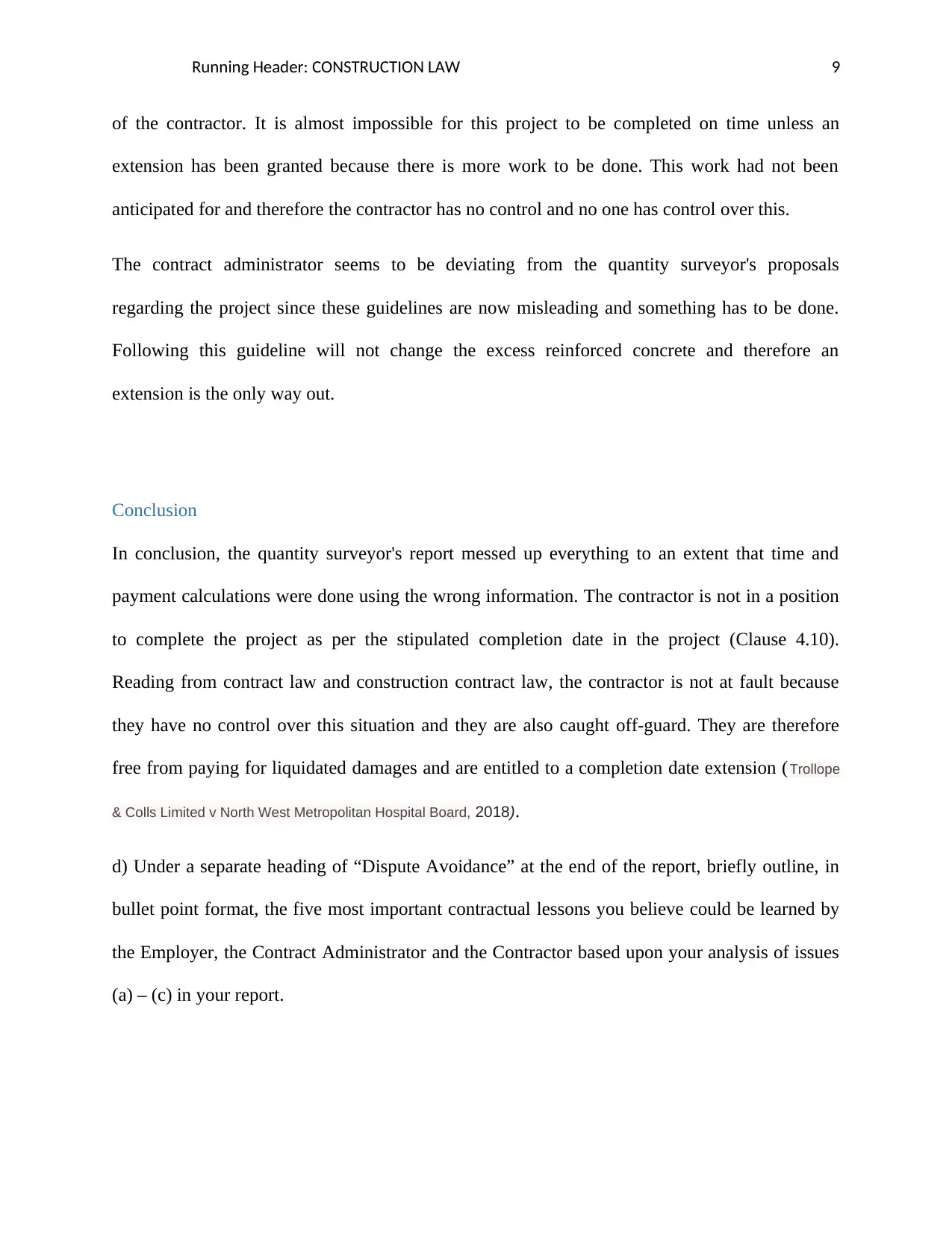
Running Header: CONSTRUCTION LAW 9
of the contractor. It is almost impossible for this project to be completed on time unless an
extension has been granted because there is more work to be done. This work had not been
anticipated for and therefore the contractor has no control and no one has control over this.
The contract administrator seems to be deviating from the quantity surveyor's proposals
regarding the project since these guidelines are now misleading and something has to be done.
Following this guideline will not change the excess reinforced concrete and therefore an
extension is the only way out.
Conclusion
In conclusion, the quantity surveyor's report messed up everything to an extent that time and
payment calculations were done using the wrong information. The contractor is not in a position
to complete the project as per the stipulated completion date in the project (Clause 4.10).
Reading from contract law and construction contract law, the contractor is not at fault because
they have no control over this situation and they are also caught off-guard. They are therefore
free from paying for liquidated damages and are entitled to a completion date extension (Trollope
& Colls Limited v North West Metropolitan Hospital Board, 2018).
d) Under a separate heading of “Dispute Avoidance” at the end of the report, briefly outline, in
bullet point format, the five most important contractual lessons you believe could be learned by
the Employer, the Contract Administrator and the Contractor based upon your analysis of issues
(a) – (c) in your report.
of the contractor. It is almost impossible for this project to be completed on time unless an
extension has been granted because there is more work to be done. This work had not been
anticipated for and therefore the contractor has no control and no one has control over this.
The contract administrator seems to be deviating from the quantity surveyor's proposals
regarding the project since these guidelines are now misleading and something has to be done.
Following this guideline will not change the excess reinforced concrete and therefore an
extension is the only way out.
Conclusion
In conclusion, the quantity surveyor's report messed up everything to an extent that time and
payment calculations were done using the wrong information. The contractor is not in a position
to complete the project as per the stipulated completion date in the project (Clause 4.10).
Reading from contract law and construction contract law, the contractor is not at fault because
they have no control over this situation and they are also caught off-guard. They are therefore
free from paying for liquidated damages and are entitled to a completion date extension (Trollope
& Colls Limited v North West Metropolitan Hospital Board, 2018).
d) Under a separate heading of “Dispute Avoidance” at the end of the report, briefly outline, in
bullet point format, the five most important contractual lessons you believe could be learned by
the Employer, the Contract Administrator and the Contractor based upon your analysis of issues
(a) – (c) in your report.
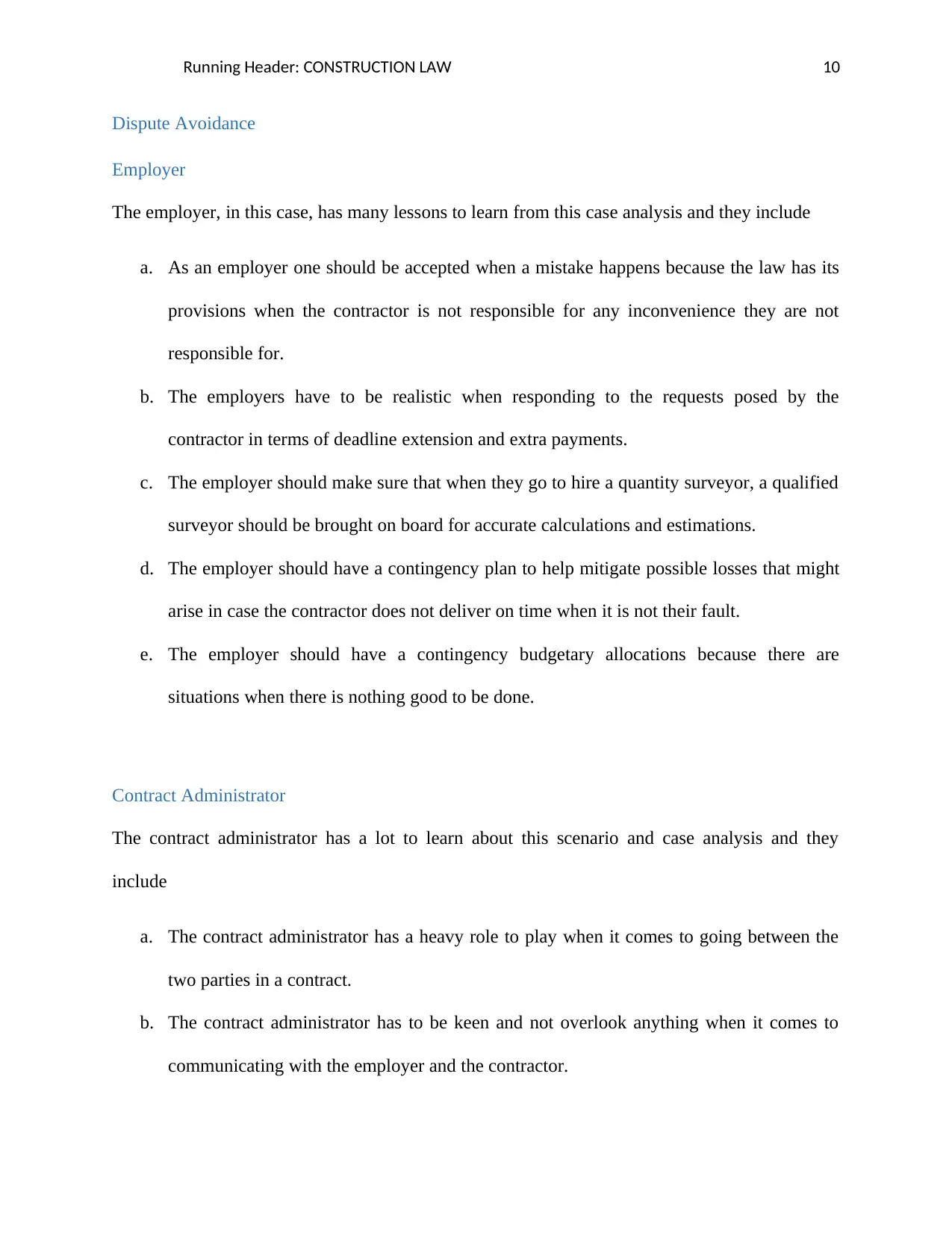
Running Header: CONSTRUCTION LAW 10
Dispute Avoidance
Employer
The employer, in this case, has many lessons to learn from this case analysis and they include
a. As an employer one should be accepted when a mistake happens because the law has its
provisions when the contractor is not responsible for any inconvenience they are not
responsible for.
b. The employers have to be realistic when responding to the requests posed by the
contractor in terms of deadline extension and extra payments.
c. The employer should make sure that when they go to hire a quantity surveyor, a qualified
surveyor should be brought on board for accurate calculations and estimations.
d. The employer should have a contingency plan to help mitigate possible losses that might
arise in case the contractor does not deliver on time when it is not their fault.
e. The employer should have a contingency budgetary allocations because there are
situations when there is nothing good to be done.
Contract Administrator
The contract administrator has a lot to learn about this scenario and case analysis and they
include
a. The contract administrator has a heavy role to play when it comes to going between the
two parties in a contract.
b. The contract administrator has to be keen and not overlook anything when it comes to
communicating with the employer and the contractor.
Dispute Avoidance
Employer
The employer, in this case, has many lessons to learn from this case analysis and they include
a. As an employer one should be accepted when a mistake happens because the law has its
provisions when the contractor is not responsible for any inconvenience they are not
responsible for.
b. The employers have to be realistic when responding to the requests posed by the
contractor in terms of deadline extension and extra payments.
c. The employer should make sure that when they go to hire a quantity surveyor, a qualified
surveyor should be brought on board for accurate calculations and estimations.
d. The employer should have a contingency plan to help mitigate possible losses that might
arise in case the contractor does not deliver on time when it is not their fault.
e. The employer should have a contingency budgetary allocations because there are
situations when there is nothing good to be done.
Contract Administrator
The contract administrator has a lot to learn about this scenario and case analysis and they
include
a. The contract administrator has a heavy role to play when it comes to going between the
two parties in a contract.
b. The contract administrator has to be keen and not overlook anything when it comes to
communicating with the employer and the contractor.
Secure Best Marks with AI Grader
Need help grading? Try our AI Grader for instant feedback on your assignments.
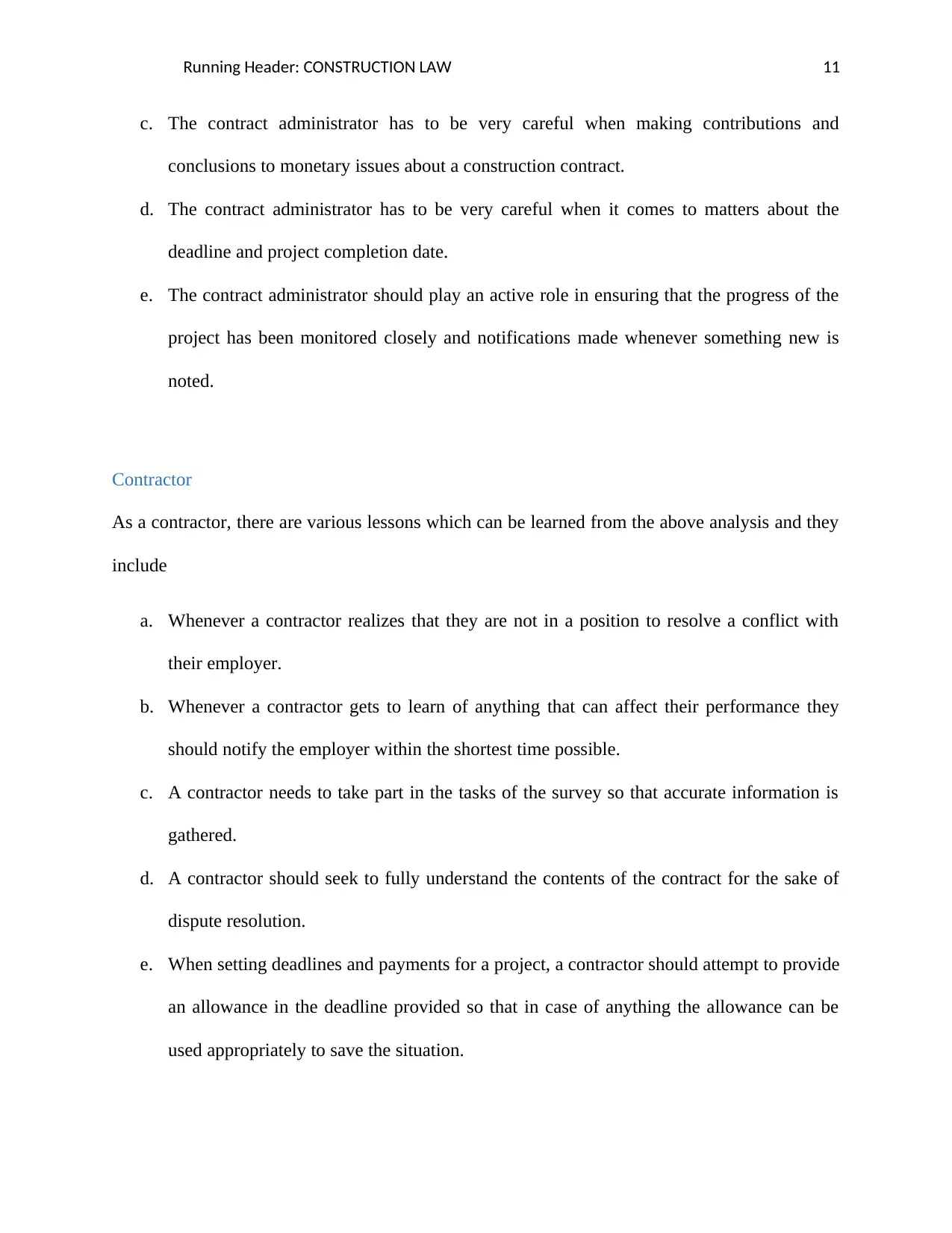
Running Header: CONSTRUCTION LAW 11
c. The contract administrator has to be very careful when making contributions and
conclusions to monetary issues about a construction contract.
d. The contract administrator has to be very careful when it comes to matters about the
deadline and project completion date.
e. The contract administrator should play an active role in ensuring that the progress of the
project has been monitored closely and notifications made whenever something new is
noted.
Contractor
As a contractor, there are various lessons which can be learned from the above analysis and they
include
a. Whenever a contractor realizes that they are not in a position to resolve a conflict with
their employer.
b. Whenever a contractor gets to learn of anything that can affect their performance they
should notify the employer within the shortest time possible.
c. A contractor needs to take part in the tasks of the survey so that accurate information is
gathered.
d. A contractor should seek to fully understand the contents of the contract for the sake of
dispute resolution.
e. When setting deadlines and payments for a project, a contractor should attempt to provide
an allowance in the deadline provided so that in case of anything the allowance can be
used appropriately to save the situation.
c. The contract administrator has to be very careful when making contributions and
conclusions to monetary issues about a construction contract.
d. The contract administrator has to be very careful when it comes to matters about the
deadline and project completion date.
e. The contract administrator should play an active role in ensuring that the progress of the
project has been monitored closely and notifications made whenever something new is
noted.
Contractor
As a contractor, there are various lessons which can be learned from the above analysis and they
include
a. Whenever a contractor realizes that they are not in a position to resolve a conflict with
their employer.
b. Whenever a contractor gets to learn of anything that can affect their performance they
should notify the employer within the shortest time possible.
c. A contractor needs to take part in the tasks of the survey so that accurate information is
gathered.
d. A contractor should seek to fully understand the contents of the contract for the sake of
dispute resolution.
e. When setting deadlines and payments for a project, a contractor should attempt to provide
an allowance in the deadline provided so that in case of anything the allowance can be
used appropriately to save the situation.

Running Header: CONSTRUCTION LAW 12
References
Martin Grant & Co Ltd v Sir Lindsay Parkinson & Co Ltd 29 BLR 31.
Lush, J in Jones and Another v The President and Scholars of St. John's College, Oxford
(1870-71) LR 6 QB 115.
Trollope & Colls Limited v North West Metropolitan Hospital Board [1973] 1 WLR 601, 609.
Shell UK Limited v Lostock Garages Limited [1976] 1 WLR 1187. See also Blackford &
Sons (Calne)
References
Martin Grant & Co Ltd v Sir Lindsay Parkinson & Co Ltd 29 BLR 31.
Lush, J in Jones and Another v The President and Scholars of St. John's College, Oxford
(1870-71) LR 6 QB 115.
Trollope & Colls Limited v North West Metropolitan Hospital Board [1973] 1 WLR 601, 609.
Shell UK Limited v Lostock Garages Limited [1976] 1 WLR 1187. See also Blackford &
Sons (Calne)
1 out of 12
Your All-in-One AI-Powered Toolkit for Academic Success.
+13062052269
info@desklib.com
Available 24*7 on WhatsApp / Email
![[object Object]](/_next/static/media/star-bottom.7253800d.svg)
Unlock your academic potential
© 2024 | Zucol Services PVT LTD | All rights reserved.